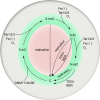Role of ten-eleven translocation proteins and 5-hydroxymethylcytosine in hepatocellular carcinoma
- PMID: 31033072
- PMCID: PMC6668972
- DOI: 10.1111/cpr.12626
Role of ten-eleven translocation proteins and 5-hydroxymethylcytosine in hepatocellular carcinoma
Abstract
In mammals, methylation of the 5th position of cytosine (5mC) seems to be a major epigenetic modification of DNA. This process can be reversed (resulting in cytosine) with high efficiency by dioxygenases of the ten-eleven translocation (TET) family, which perform oxidation of 5mC to 5-hydroxymethylcytosine (5hmC), 5-formylcytosine and 5-carboxylcytosine. It has been demonstrated that these 5mC oxidation derivatives are in a dynamic state and have pivotal regulatory functions. Here, we comprehensively summarized the recent research progress in the understanding of the physiological functions of the TET proteins and their mechanisms of regulation of DNA methylation and transcription. Among the three TET genes, TET1 and TET2 expression levels have frequently been shown to be low in hepatocellular carcinoma (HCC) tissues and received most attention. The modulation of TET1 also correlates with microRNAs in a post-transcriptional regulatory process. Additionally, recent studies revealed that global genomic 5hmC levels are down-regulated in HCC tissues and cell lines. Combined with the reported results, identification of 5hmC signatures in HCC tissues and in circulating cell-free DNA will certainly contribute to early detection and should help to design therapeutic strategies against HCC. 5hmC might also be a novel prognostic biomarker of HCC. Thus, a detailed understanding of the molecular mechanisms resulting in the premalignant and aggressive transformation of TET proteins and cells with 5hmC disruption might help to develop novel epigenetic therapies for HCC.
Keywords: 5-hydroxymethylcytosine; TET proteins; epigenetic biomarkers; hepatocellular carcinoma; therapy and prognosis.
© 2019 The Authors. Cell Proliferation Published by John Wiley & Sons Ltd.
Conflict of interest statement
No potential conflicts of interest existed.
Figures


Similar articles
-
Decrease of 5-hydroxymethylcytosine is associated with progression of hepatocellular carcinoma through downregulation of TET1.PLoS One. 2013 May 9;8(5):e62828. doi: 10.1371/journal.pone.0062828. Print 2013. PLoS One. 2013. PMID: 23671639 Free PMC article.
-
Tumor development is associated with decrease of TET gene expression and 5-methylcytosine hydroxylation.Oncogene. 2013 Jan 31;32(5):663-9. doi: 10.1038/onc.2012.67. Epub 2012 Mar 5. Oncogene. 2013. PMID: 22391558 Free PMC article.
-
Global DNA 5-Hydroxymethylcytosine and 5-Formylcytosine Contents Are Decreased in the Early Stage of Hepatocellular Carcinoma.Hepatology. 2019 Jan;69(1):196-208. doi: 10.1002/hep.30146. Epub 2018 Dec 17. Hepatology. 2019. PMID: 30070373
-
Tet family proteins and 5-hydroxymethylcytosine in development and disease.Development. 2012 Jun;139(11):1895-902. doi: 10.1242/dev.070771. Development. 2012. PMID: 22569552 Free PMC article. Review.
-
TET proteins and 5-methylcytosine oxidation in hematological cancers.Immunol Rev. 2015 Jan;263(1):6-21. doi: 10.1111/imr.12239. Immunol Rev. 2015. PMID: 25510268 Free PMC article. Review.
Cited by
-
Novel Epigenetics Control (EpC) Nanocarrier for Cancer Therapy Through Dual-Targeting Approach to DNA Methyltransferase and Ten-Eleven Translocation Enzymes.Epigenomes. 2025 Feb 11;9(1):6. doi: 10.3390/epigenomes9010006. Epigenomes. 2025. PMID: 39982248 Free PMC article.
-
Epigenetic reprogramming in cancer: From diagnosis to treatment.Front Cell Dev Biol. 2023 Feb 14;11:1116805. doi: 10.3389/fcell.2023.1116805. eCollection 2023. Front Cell Dev Biol. 2023. PMID: 36866275 Free PMC article. Review.
-
Epigenetic mechanisms of liver tumor resistance to immunotherapy.World J Hepatol. 2021 Sep 27;13(9):979-1002. doi: 10.4254/wjh.v13.i9.979. World J Hepatol. 2021. PMID: 34630870 Free PMC article. Review.
-
Effect of Zebularine on p16INK4a, p14ARF, p15INK4b, and DNA Methyltransferase 1 Gene Expression, Cell Growth Inhibition, and Apoptosis Induction in Human Hepatocellular Carcinoma PLC/PRF5 and Pancreatic Cancer PA-TU-8902 Cell Lines.Iran J Pharm Res. 2020 Fall;19(4):193-202. doi: 10.22037/ijpr.2020.112223.13614. Iran J Pharm Res. 2020. PMID: 33841535 Free PMC article.
-
Epigenetic tumor heterogeneity in the era of single-cell profiling with nanopore sequencing.Clin Epigenetics. 2022 Aug 27;14(1):107. doi: 10.1186/s13148-022-01323-6. Clin Epigenetics. 2022. PMID: 36030244 Free PMC article. Review.
References
-
- Bruix J, Reig M, Sherman M. Evidence‐based diagnosis, staging, and treatment of patients with hepatocellular carcinoma. Gastroenterology. 2016;150(4):835‐853. - PubMed
-
- Parikh ND, Singal AG, Hutton DW. Cost effectiveness of regorafenib as second‐line therapy for patients with advanced hepatocellular carcinoma. Cancer. 2017;123(19):3725‐3731. - PubMed
Publication types
MeSH terms
Substances
LinkOut - more resources
Full Text Sources
Medical

